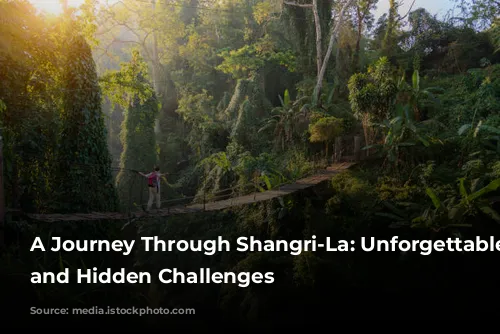Shangri-La, a mystical land nestled in the heart of the Himalayas, draws travelers from across the globe with its awe-inspiring natural beauty. From snow-capped peaks to crystal-clear lakes, the region promises an adventure unlike any other. But while the allure of Shangri-La is undeniable, it’s important to be aware of the potential challenges that may arise during your journey.

Tiger Leaping Gorge: A Spectacle Marred by Management
Imagine standing at the edge of a dramatic canyon, the mighty Yangtze River thundering below, the Jade Dragon Snow Mountain soaring above. This is the breathtaking vista that awaits you at the Tiger Leaping Gorge. Yet, despite its stunning beauty, the Tiger Leaping Gorge suffers from inefficient management, often leaving visitors frustrated.
Picture this: a half-hour tour that takes two hours to complete due to long queues. Even during the off-season, you might find yourself trapped in a sea of parked cars at the gate, as the scenic bus remains unavailable. The only way to enter the gorge is through a gridlock of self-driven vehicles. While during peak season, the scenic bus offers relief, the sheer volume of people is a constant reminder of the management struggles. It’s a shame that such a remarkable place is marred by overcrowding and a lack of efficient planning. Can’t the authorities adjust their approach based on visitor numbers to ensure a more enjoyable experience?

Balagezong Scenic Area: Beauty With a Price
Balagezong Scenic Area beckons with its rugged mountainous landscape, offering a glimpse into the untamed beauty of Shangri-La. However, navigating this sprawling area can prove challenging, especially if you’re aiming to see all the attractions in a single day.
The Bala Village, a relic of the past, holds a special place in history. Now deserted, it’s a popular spot for a photo op, allowing visitors to learn about the region’s fascinating past. However, the rest of the area lacks significant attractions, making the journey feel somewhat incomplete.
The highlight of Balagezong is the Barafota Tower, accessible only via a designated shuttle service. While reaching the summit offers incredible views, limited playtime and infrequent shuttle departures limit your opportunity to truly immerse yourself in the experience. If you desire to explore every corner of Balagezong, you’ll find that time is a luxury.
The key takeaway is that a truly enriching experience in Balagezong often comes at a cost. While the Shambhala Buddha is a worthwhile attraction, other areas may leave you wanting more. It’s essential to set realistic expectations and plan your time carefully to make the most of your visit.

Dukezong Ancient Town: A Historical Gem in the Heart of Shangri-La
Dukezong Ancient Town, one of the largest and best-preserved Tibetan settlements in China, embodies the rich history and culture of the region. Situated in Shangri-La, the town has its roots in the Tang Dynasty, when it was established as a fortified outpost on the imposing Guishan Mountain.
The name “Dukezong” holds significance in Tibetan language, signifying both a “castle built on stone” and a “moonlight city”. Throughout centuries, the town served as a vital hub along the ancient tea horse road, welcoming weary travelers from the vast Tibetan plateau. Today, Dukezong stands as a testament to this vibrant past.
A stroll through the town’s bustling streets reveals a plethora of shops, restaurants, and inns, reminiscent of the ancient trade routes that once brought merchants from far and wide. The Big Buddha Temple, perched atop Guishan Mountain, and the world’s largest prayer wheel, erected in 2002, are prominent landmarks, offering a glimpse into the town’s spiritual heart. The prayer wheel, a symbol of Shangri-La’s renaming from Zhongdian, is a breathtaking sight, a testament to the town’s rich cultural heritage.
While Dukezong retains its traditional charm, it has also embraced modern tourism, offering a blend of the old and the new. However, it’s crucial to remember that its history, architecture, and spirituality are what make it truly unique. As you explore the ancient town, take a moment to appreciate the legacy it carries and the cultural tapestry it weaves.

Wu Di Hu: A Serene Escape Amidst Pristine Nature
Escape the hustle and bustle of Shangri-La and embark on a journey to Wu Di Hu, a breathtaking plateau lake nestled in the heart of Shangri-La’s Dilong Snow Mountain. Known as “Vardicuo” in Tibetan, meaning “bottomless lake,” this gem of nature offers a mesmerizing escape into the tranquility of the Himalayas.
Standing at an impressive 3,800 meters above sea level, Wu Di Hu is a symphony of pristine landscapes. The surrounding snow-capped mountains reflect their majesty in the clear, blue waters, creating a picture-perfect scene that will linger in your memory long after you leave.
A walk around the lake unveils a breathtaking tapestry of nature. Lush forests, moss-covered meadows, and nomadic camps weave together, forming a haven for peace and tranquility. The lake itself is a mesmerizing sight, its placid surface mirroring the surrounding beauty.
A trip to Wu Di Hu is an invitation to reconnect with nature, to embrace the serenity that only the Himalayas can offer. This off-the-beaten-path destination provides a much-needed respite from the crowds and a chance to truly immerse yourself in the wonder of Shangri-La.

Haba Snow Mountain: A Climber’s Paradise
For the adventurous soul, a journey to Haba Snow Mountain is a must. The highest peak within the World Natural Heritage Reserve, Haba Snow Mountain is a majestic sight, a tapestry of snow-capped peaks, steep canyons, cascading waterfalls, and lush forests. Scientists hail it as “the most visual thermometer on the planet” and a sanctuary for rare and endangered flora and fauna.
While conquering Haba Snow Mountain poses a challenge, with its altitude, climate, and rugged terrain, it is accessible to even novice climbers with proper preparation and guidance. This makes it a popular destination for those seeking to test their limits and experience the thrill of summiting a snow-capped peak.
A three-day itinerary takes you through the heart of the mountain, allowing you to experience its diverse landscape firsthand. From the scenic Haba Village at the mountain’s base to the challenging climb to the summit, the journey is an adventure waiting to unfold.
The ascent is a gradual progression, leading you through breathtaking landscapes, from lush forests and meadows to the ice-covered slopes of the summit. Along the way, you’ll be accompanied by experienced guides, ensuring your safety and providing valuable insights into the mountain’s ecosystem.
Haba Snow Mountain offers a unique blend of natural beauty and challenging adventure. It’s an ideal destination for those seeking a thrilling experience amidst the stunning grandeur of the Himalayas.









